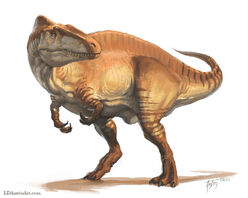| Acrocanthosaurus | ||||
|---|---|---|---|---|

| ||||
| Name | Acrocanthosaurus | |||
| Class | Reptilia | |||
| Name Translation | High-spined lizard | |||
| Period | Early Cretaceous | |||
| Location | Oklahoma, Texas | |||
| Diet | Meat | |||
| Size | 33 to 41 feet (10 to 12.5 meters) | |||
Acrocanthosaurus was a very large theropod allosaurid dinosaur from North America during the Early Cretaceous Period about 112 million years ago.
Discovery
In 1950, a team of scientists, led by paleontologists J. Willis Stovall and Wann Langston, Jr, was excavating in the deserts of Oklahoma when they came across very large fossilized bones and tall vertebrae. They were taken to a nearby museum and were found to belong to a new species of very large theropod dinosaur. It wasn't long afterward that it was officially named Acrocanthosaurus atokensis, or "Atoka's high-spined lizard", after the tall spines along its back and the area in Oklahoma where it was first found. However, it was first discovered in 1940s but hadn't gained any attention until its rediscovery a decade later. Since then, several more Acrocanthosaurus specimens have been found, and even a very well preserved fossil trackway of it chasing down a Sauroposeidon. It's been found in several states along the western half of America, including Oklahoma, Texas, Wyoming, Arizona, and even as far east as Maryland some specimens have been found, suggesting Acrocanthosaurus was a very successful predator. And in 2012, the pubic bones, vertebrae, and fibula of a juvenile Acrocanthosaurus were found in the Cloverly Formation in Wyoming, suggesting this theropod was the only large predator in this formation during the time of the dinosaurs.
Description
Acrocanthosaurus was a large carnosaur theropod dinosaur that had a large head, many sharp teeth, strong arms, powerful back legs, and a long slender tail that balanced its body when it ran. It lived alongside the small raptor Deinonychus, some small ankylosaurs, and hunted large sauropods. Acrocanthosaurus had one feature that made it look very different from other theropods; the tall "sail" along its neck, back, and tail. The sail was formed by very tall spines on the bones of the spine (vertebrae). Some of these spines were over a foot tall. It may represent an evolutionary link between the Late Jurassic Allosaurus and the gigantic Early Cretaceous Carcharodontosaurus. It was one of the largest bipedal carnivorous dinosaurs, with one mounted specimen reaching a length of possibly 12.5 meters (41 feet) and an estimated weight of 4 to 6 tons. Many of its vertebrae had high neural spines.
Scientists have debated why Acrocanthosaurus had a sail along its back. Some think it released heat when the animal was too hot. It also may have been used for display to make the animal look bigger when it faced rivals for territories or mates. This is much like a house cat fluffing up its fur and arching its back to make itself look bigger. There are other large tall-spined dinosaurs from Europe and Africa, but scientists don't know how Acrocanthosaurus

Acrocanthosaurus
is related to them. Altispinax had spines almost three-feet tall and Spinosaurus had six foot tall spines on its back. Paleontologists have built the dinosaur from parts of three skeletons. One skeleton had a three-foot-long skull. An adult Acrocanthosaurus was about ten feet tall at the hips and weighed between three to five tons.
Scientists have found footprints probably made by Acrocanthosaurus in several places in Texas. In one place, it looks like an Acrocanthosaurus stalked a large sauropod across a mud flat, possibly Sauroposeidon. When the sauropod footprints changed direction, so did those of Acrocanthosaurus. The outcome of this discovery shows that the Acrocanthosaurus' jaws were hanging onto one of the thighs of the sauropod while the it was running. The predator would then rip out a chunk of flesh and the sauropod later died of loss of blood and infection. This discovery concluded that Acrocanthosaurus was known for hunting large sauropods, something that most carnivores would never do.
Popular Culture
Acrocanthosaurus appears in the Vivendi Universal video game Jurassic Park: Operation Genesis for PC and console platforms.
Acrocanthosaurus also appears in Robert Bakker's novel "Raptor Red" about Utahraptor.
Acrocanthosaurus appeared in the Dreamworks Interactive video game Warpath: Jurassic Park for the Sony Playstation game console
Acrocanthosaurus also appears in Monsters Resurrected: Great American Predator (known as Mega Beast: Dinosaur King in some versions) as top predator and being driven to extinction by climate change and help from Deinonynchus (in real life, Deinonynchus wouldn't be much competition for the larger theropod) and taking down large sauropods.
It also appears in the Discovery Channel show Prehistoric as predator to Astrodon.
Acrocanthosaurus makes a cameo in Planet Dinosaur: Episode 5.
It also make some appearances in Dinosaur King.
References
Websites:
http://en.wikipedia.org/wiki/Acrocanthosaurus
http://dinosaurs.about.com/od/carnivorousdinosaurs/p/acrocanthosaurus.htm
http://animal.discovery.com/dinosaurs/acrocanthosaurus.htm
http://www.prehistoric-wildlife.com/species/a/acrocanthosaurus.html
http://www.dinochecker.com/dinosaurs/ACROCANTHOSAURUS
Documentaries:
Mosters Resurrected: Great American Predator
Prehistoric Dallas
Prehistoric DC
Books:
The Audubon Society Pocket Guides Familiar Dinosaurs; by Alfred A. Knopf






